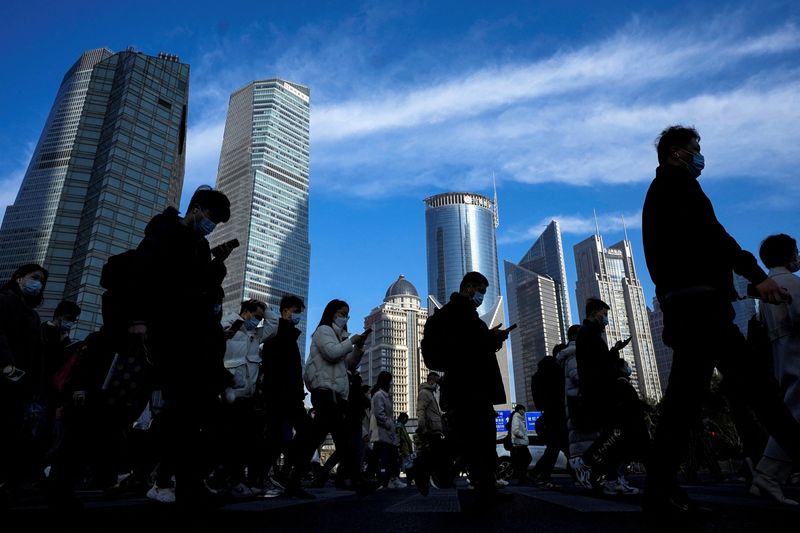By Judy Hua and Kevin Yao
BEIJING (Reuters) -China reported unexpectedly strong credit growth for February, with money supply expanding at the fastest pace in nearly 7 years, as Beijing looks to support a nascent economic recovery amid rising global risks.
The government's lifting of harsh pandemic curbs in December and other measures have started to rekindle credit demand in the world's second-largest economy, after a COVID-induced slump rattled business and consumer confidence. But there are some fears that momentum could fade after the initial bounce.
"China's strong credit extension in February has somehow offset the recent concerns clouding the pace of economic recovery, suggesting that the overall economy is still on a solid footing," said Zhou Hao, economist at Guotai Junan International.
Growth of outstanding total social financing (TSF), a broad measure of credit and liquidity in the economy, quickened to 9.9% in February from a year earlier, the highest since November 2022, and rising from 9.4% in January.
TSF includes off-balance sheet forms of financing that exist outside the conventional bank lending system, such as initial public offerings, loans from trust companies and bond sales.
Other key credit gauges also showed a solid pick-up.
Broad M2 money supply grew 12.9% from a year earlier, central bank data showed on Friday, the strongest pace since March 2016. That was well above estimates of 12.5% in the Reuters poll and a 12.6% pace in January.
New bank lending fell much less than expected in February from a record high the previous month.
Banks extended 1.81 trillion yuan ($260 billion) in new loans last month. Analysts had predicted they would fall to 1.50 trillion yuan from 4.9 trillion yuan in January, and compared with 1.23 trillion yuan a year earlier.
A pull-back in February loans from January had been widely expected because Chinese banks tend to front-load loans at the beginning of the year to get higher-quality customers and win market share.
Also, the central bank had told some banks to slow the pace of lending to contain risks after January's record credit spree, three bankers told Reuters last month.
LIMITED ROOM
China has set a modest target for economic growth this year of around 5% after it cooled to only 3% last year, the weakest in nearly half a century.
The central bank has pledged to make timely policy adjustments to support growth, but analysts believe it has limited room to maneuver due to worries over capital flight amid continued policy tightening by the Federal Reserve.
While the economy has made a tentative recovery in the last two months, data has been somewhat mixed.
China's factory sector grew in February at the fastest pace in more than a decade, the mobility of people and goods is clearly improving, and falling new home prices may have steadied. But consumer inflation unexpectedly slowed in February as consumers remain cautious, while exports and imports fell again.
Among other closely watched credit measures, outstanding yuan loans grew 11.6% in February from a year earlier -- the highest since December 2021 and compared with 11.3% growth in January. Analysts had expected 11.4% growth.
TSF for the month of February fell to 3.16 trillion yuan from 5.98 trillion yuan in January, but was still well ahead of expectations for 2.20 trillion yuan.
But Friday's credit data also pointed to some unevenness.
Household loans, mostly mortgages, fell to 208.1 billion yuan in February from 257.2 billion yuan in January, while corporate loans fell to 1.61 trillion yuan from 4.68 trillion yuan.
However, new household deposits fell sharply to 792.6 billion yuan in February from 6.2 trillion yuan in January. Analysts are closely watching that figure for signs that shell-shocked consumers are spending again after a year of lockdowns and job losses battered sentiment.
Capital Economics said in a note to clients it expects credit growth to improve further in coming months, citing signs of improvement in the battered property sector, but it warned of risks.

"This credit cycle will not receive much of a tailwind from policy easing – the NPC (parliament) signalled a stable fiscal stance and little in the way of additional monetary support," Capital Economics said in a note to clients.
"As such, the rebound in credit growth may fizzle out later in the year once the initial reopening boost has run its course."